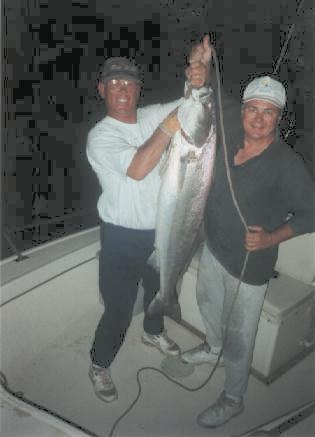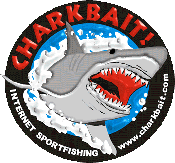Fishing Catalina's West End
by Capt. Jerry Barber
I have a job most people would kill for. During the past five
summers, I've worked as a Harbor Patrolman at the Isthmus on Catalina Island. This allows
me to live, work and fish some of the most beautiful and productive waters in Southern
California. Over the years, I've talked with many boaters at trade shows, boat and tackle
shows, and club meetings about boating and fishing at Catalina. Quite a few express
surprise when I tell them I regularly cross the channel in an 18 foot Parker center
console. I emphasize that I have a good boat, proper equipment and watch the weather. For
those of you who have never visited the island in a small boat, I would like to offer a
few tips and say Come on over!
The first thing I would recommend is good equipment. I have seen boats come to the Isthmus
that I wouldn't take out in the bay in calm weather. If you have a good seaworthy boat, a
properly maintained motor, a working VHF radio, a calibrated compass, a GPS and all the
required safety equipment, there is no reason you shouldn't be able to make the trip
safely. One piece of safety equipment I want to especially mention is your anchor. Be sure
you have an anchor of the appropriate size, with sufficient chain and rode. Catalina
Island is not the place to come if you have a small folding anchor, 5 feet of 1/4"
chain (or no chain at all!) and 100 feet of 1/4" or 3/8" line. Believe me, I
have seen this all too often. You will need an anchor that will hold your boat in deep
water and in open ocean conditions. I also mentioned a VHF radio... not a Citizens Band
radio, not a cellular telephone or anything else. A working VHF radio is an absolute
essential piece of equipment. It can save your life.
Once at Catalina, there are many places to safely anchor or, if you prefer, pick up a
mooring. A phone call to the Visitor Services Office at (310) 510-0303 will get you a
pamphlet containing loads of useful information about the island. It will describe the
locations of the mooring coves and give you places to pick up fuel and supplies. All
moorings at the island are rented on a first-come, first-served basis. Avalon monitors VHF
12 and the rest of the island monitors VHF 09. If you wish to pick up a mooring and have
never done so before, PLEASE tell this to the Harbor Patrolman. It is a very simple
procedure, but it can be screwed up very badly and can get very expensive if you chew up
the mooring tackle with your prop. We will be glad to accompany you to the mooring and
help you get properly secured.
Since you found this article at a site primarily dealing with fishing, I probably should
comment on that. Fishing is a major part of my life. As I mentioned before, I work as a
Harbor Patrolman at the Isthmus during the summer months. In addition to my Harbor Patrol
duties, I also occasionally run fishing and diving charters out of the Two Harbors area.
During the winter months, I run harbor cruises, whale watch tours and fishing trips out of
Helgren's Sportfishing at Oceanside Harbor.
Most of the good fishing spots around Catalina Island are well known and well documented.
There are several fine books with all the spots identified by landmarks and/or
latitude/longitude numbers. I am most familiar with the area around the West End and will
be more than happy to share the local up-to-date information with you when you come into
the Isthmus. Contact any Harbor Patrolman and they will tell you how to contact me. I am
almost always on VHF 09 and will answer to Sea H.P., the name of my boat.
The primary fish of interest at the Isthmus is the white seabass, although yellowtail,
yellowfin tuna, striped marlin, mako's, thresher's and occasionally dorado and bluefin
tuna also generate a lot of interest. At this time, no live bait is commercially available
at the island. You must bring it across from the mainland or catch it locally. I usually
recommend trying Ship Rock for bait (beware of the reef that runs south from the rock),
although Bird Rock and Eagle Reef are also good. The locals usually use canned cat food to
entice mackerel to the boat but a mesh bag of dry dog food also works well. Squid can be
found at certain times of the year but most of us rely on mackerel or blacksmith for bait.
Once bait is obtained, I usually recommend trying the High Spot, a pile of rocks that lies
between Bird Rock and Ship Rock, or Eagle Reef. These spots are just minutes from the
Isthmus itself and are both convenient and productive. Other well-known seabass spots
include Long Point, Johnson Rock (be careful at night...it's not lighted and extremely
dangerous), Eagle Rock and West Cove. These are all on the charts, along with other
equally good locations. I should point out that the typical white seabass at the West End
exceeds 30 pounds so appropriate tackle is necessary. These fish are not only hard
fighters, they are delicious table fare.
Seabass tackle is identical to a good yellowtail or light tuna rig. I personally use a
270H rod with an Accurate Penn 500 reel and 25# line. Good, well-maintained equipment is
an absolute necessity. You will need good quality line and a reel with good smooth drags.
You might sit out on anchor for three, four or five nights in a row without getting bit,
so when you do, your gear had better be ready. You typically only get one or two shots a
night at them during normal conditions. A three-fish limit is rare. I recommend using 25
or 30 pound test line with a good 3/0 hook and an egg sinker of appropriate weight secured
with a Carolina keeper about four feet above the hook. If Carolina keepers are not
available, tie a snell knot around the main line to secure the sinker. I much prefer these
devices to split shot which can nick the main line. Once I hook a seabass, I get very
upset when I lose it. Fishing for seabass is identical to fishing for deep yellowtail.
Drop to the bottom, wind up six to ten cranks, take the reel out of gear and wait. Seabass
will sometimes take a bait in short jerks, similar to a calico strike, but can hit like a
freight train. I once had one hit so hard that I lost over 40 yards of line before I could
get the rod out of the holder and in gear! They will typically fight very hard for five to
ten minutes and then they'll give up and come to the boat fairly easily. Let them fight
the drags and wear themselves out. Don't try to horse them in. Once they quit, they come
right in.
|
 The island
is waiting. Get your boats and gear ready and come on over! The fishing is great! Once
you've done it, you'll wonder why you didn't try it earlier.
The island
is waiting. Get your boats and gear ready and come on over! The fishing is great! Once
you've done it, you'll wonder why you didn't try it earlier. 